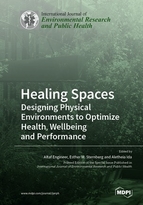Healing Spaces: Designing Physical Environments to Optimize Health, Wellbeing and Performance
A special issue of International Journal of Environmental Research and Public Health (ISSN 1660-4601). This special issue belongs to the section "Environmental Health".
Deadline for manuscript submissions: closed (31 October 2019) | Viewed by 72139
Special Issue Editors
Interests: design and health; wearable devices; stress response; built environment
Interests: health and the built environment; equitable design; new building technologies; daylighting; social and behaviorial issues in design
Special Issue Information
Dear Colleagues,
The field of design and health, previously the domain of healthcare design professionals, has now reached a turning point with the proliferation of a plethora of non-invasive wearable technologies to provide objective and near-real-time measurement of the impact of many features of the built environment on aspects of health, wellbeing and performance. In turn, new materials and the Internet of Things are allowing the development of smart buildings, which can interact with occupants to optimize their health, wellbeing, performance and overall experience. Companies previously focused on positioning themselves as “green” are now turning to positioning themselves in the marketplace as both green and healthy. This Special Issue will include articles that address new cutting edge technologies and materials at the interface between design and health, will review some of the latest findings of studies using these technologies, and will suggest exciting future directions for the field. It will include articles focused on objective data gathered to document the effects of the built environment on health. Importantly, it will focus on the use of innovative methods of measurement, such as state-of-the-art wearable and environmental sensors, quantifying aspects of health such as stress and relaxation responses, activity, posture, sleep quality, cognitive performance and wellbeing outcomes. It will also examine the impacts of different elements of the built environment on these health and wellbeing outcomes. Published articles will focus on design interventions informed by these measurements, along with innovative integrated building materials that can shape the design of built environments for better health, productivity, and performance. It will also address the return on investment (ROI) of such design interventions. The Special Issue will provide both the foundational knowledge and fundamentals for characterizing human health and wellbeing in the built environment, as well as emerging trends and design methods for innovations in this field.
Prof. Dr. Esther M. Sternberg
Dr. Altaf Engineer
Dr. Aletheia Ida
Guest Editors
Manuscript Submission Information
Manuscripts should be submitted online at www.mdpi.com by registering and logging in to this website. Once you are registered, click here to go to the submission form. Manuscripts can be submitted until the deadline. All submissions that pass pre-check are peer-reviewed. Accepted papers will be published continuously in the journal (as soon as accepted) and will be listed together on the special issue website. Research articles, review articles as well as short communications are invited. For planned papers, a title and short abstract (about 100 words) can be sent to the Editorial Office for announcement on this website.
Submitted manuscripts should not have been published previously, nor be under consideration for publication elsewhere (except conference proceedings papers). All manuscripts are thoroughly refereed through a single-blind peer-review process. A guide for authors and other relevant information for submission of manuscripts is available on the Instructions for Authors page. International Journal of Environmental Research and Public Health is an international peer-reviewed open access monthly journal published by MDPI.
Please visit the Instructions for Authors page before submitting a manuscript. The Article Processing Charge (APC) for publication in this open access journal is 2500 CHF (Swiss Francs). Submitted papers should be well formatted and use good English. Authors may use MDPI's English editing service prior to publication or during author revisions.
Keywords
- New technologies in design and health
- Health and performance
- Built environment
- Smart buildings
- Internet of Things (IoT)
- Wearable devices
- Environmental sensors
- Bioresponsive design






